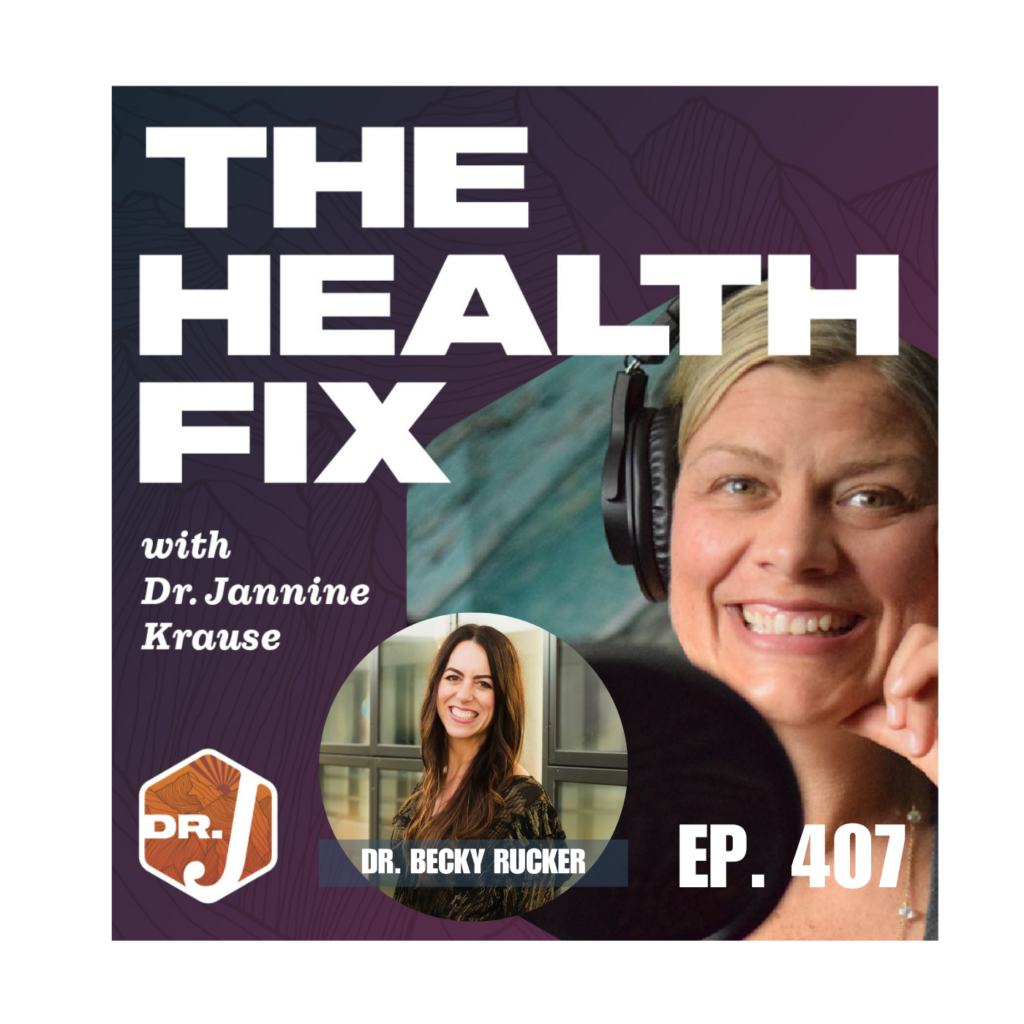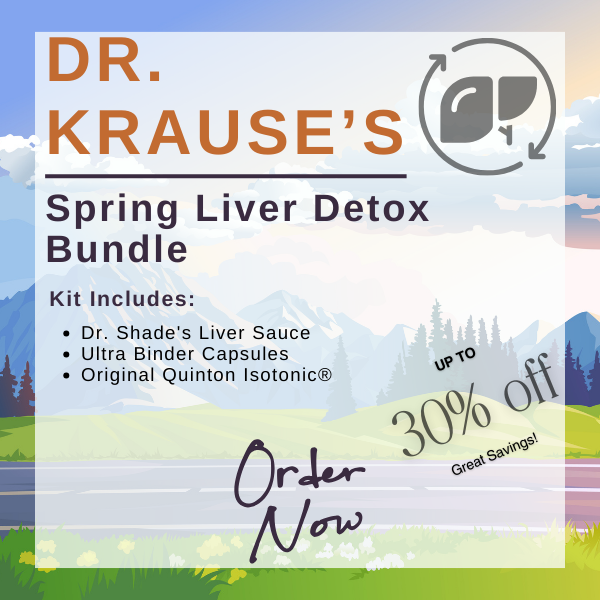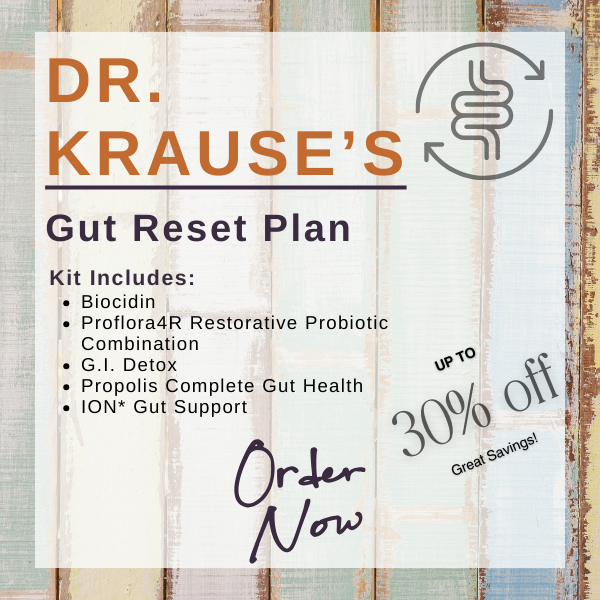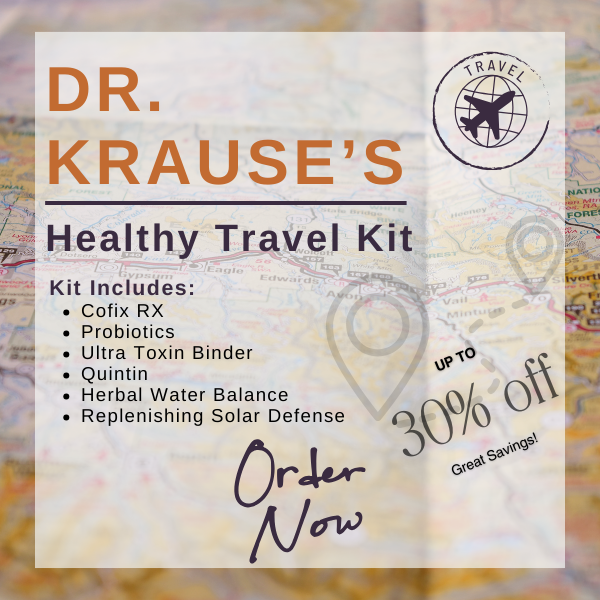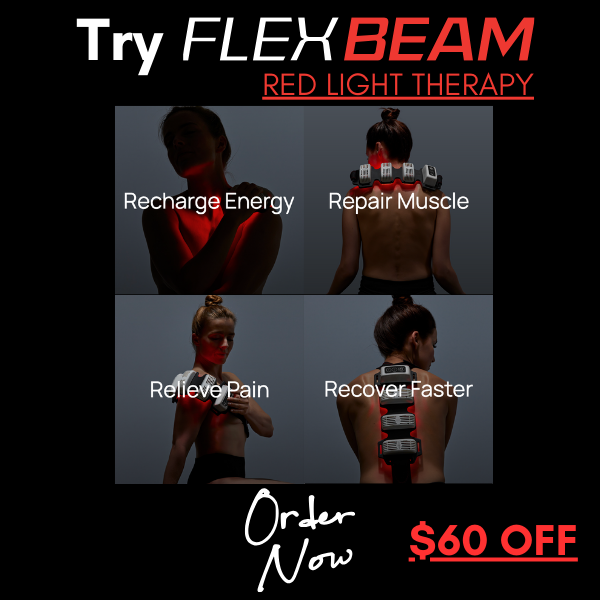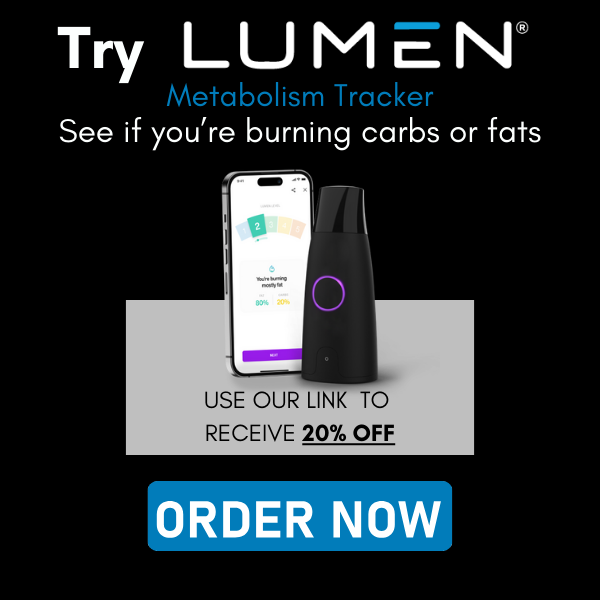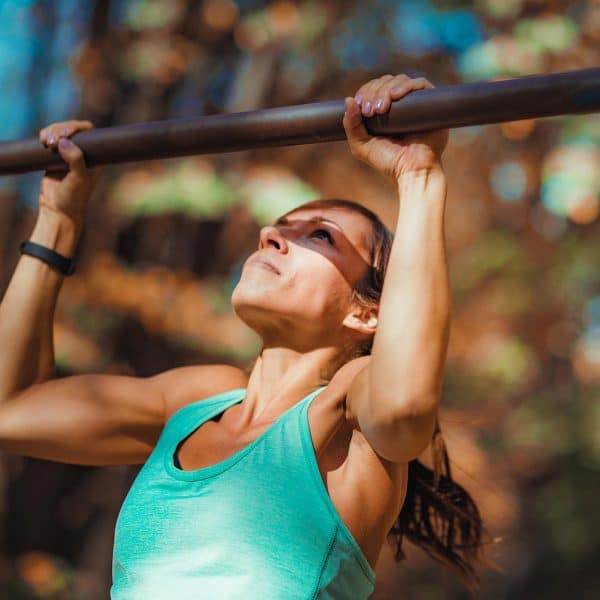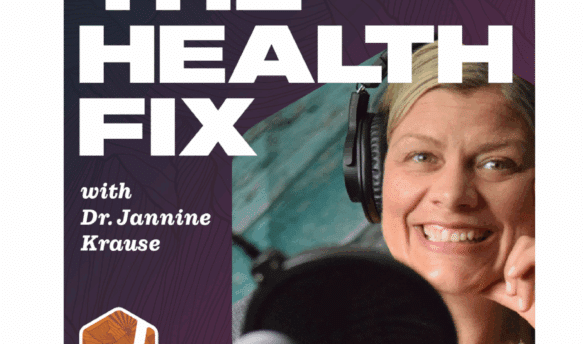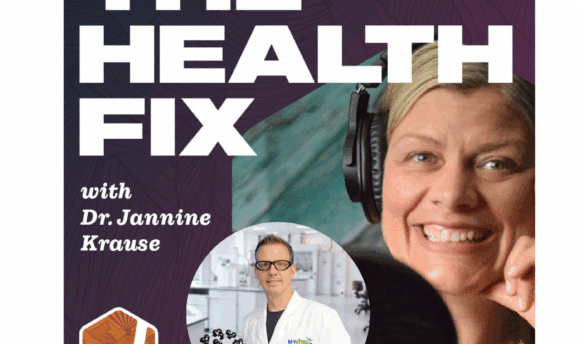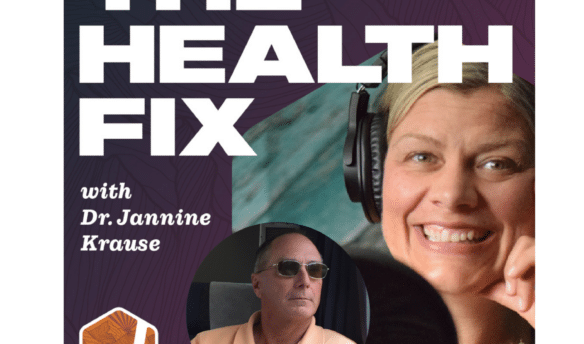Chronic back pain despite going to physical therapy, massage, or chiropractor? All the stretching, core stability work, yoga, and foam rolling not helping? Wondering if you’ll ever have a day without pain? Dr. Becky Rucker is a board certified Orthopedic Physical Therapist, Certified Strength & Conditioning Specialist and certified STOTT Pilates Fitness & Rehabilitation Instructor. She’s known for her keen eye in movement analysis and uses this skill for injury rehabilitation, sports performance, and strength and conditioning work. She’s Dr. Jannine Krause’s physical therapist and one of her go to resources for her patients when it comes to pain. In this episode of The Health Fix Podcast, Dr. Jannine Krause interviews Dr. Becky Rucker on what to assess beyond the core when it comes to low back pain and how to relieve pain while creating strength.
Dr. Krause’s Protocols
Instructions Included
Traveling soon? Looking to detox or reset your gut? Try one of Dr. Krause’s Fullscript plans.
What You’ll Learn In This Episode:
- The alarming role of the hips in low back pain
- How your upper back influences your low back
- Why you don’t want to ignore your low back stabilizer muscles
- The importance of rotational movements in optimizing back health
Resources From The Show:
- Dr. Becky Rucker’s Website – Physio Movement & Performance
- Dr. Becky’s Instagram
- Physio Movement & Performance Facebook
- Dr. Becky’s Youtube Channel
- Dr. Becky’s LinkedIn
- Book with Physio Movement & Performance
Our Partners
Podcast Transcript
JANNINE: [Intro] Welcome to the HealthFix podcast where health junkies get their weekly fix of tips, tools and techniques to have limitless energy, sharp minds and fit physics or life. Hey, HealthJunkies. On this episode of the HealthFix podcast, I’m interviewing one of my really great friends from Tacoma, Washington, Dr. Becky Rucker. She’s a board-certified orthopedic physical therapist and she’s a certified strength in conditioning specialists. She is known for her keen eye in movement analysis and boy, can she tell you what is wrong in a snap of the fingers? She uses her skill for injury rehab, sports performance, strength and conditioning work and just really helping you perform at your optimal level. And so Becky and I are going to talk all about low back pain, how the two of us have worked on mine and how low back pain is not just about your core, core strength. There’s a lot more involved in it and so today we’re going to kind of shed some light on those things and go through what you want to be thinking about when you’ve got some back pain or you want to prevent back pain. So let’s introduce you to my really good friend, Dr. Becky Rucker. Hey, HealthJunkies. Welcome to another episode of the HealthFix podcast. I have my lovely great friend from Tacoma, Becky Rucker on. She’s a physical therapist and you know, has saved my butt in a lot of situations when it comes to back pain and my body flaring up. And so today I’m going to introduce you to her, but also we’re going to share some really amazing stuff about back pain, pain in general and some of the things we’re overlooking when it comes to back pain. So Becky, welcome to the HealthFix podcast.
BECKY: Thanks so much, Janine. I’m so excited to be here just to talk about low back pain, just chat with you about our experience together and also hopefully help everybody else out there with their issues with low back pain.
JANNINE: Yeah. No, I have no doubt that we’re going to help folks because you know, I, in the medical field, you know, we think we have it all covered when it comes to back pain. We’re like, yeah, you know, work on the core. That’s all we have to do when I came to you. I was like, yeah, I’m doing CrossFit. I’m lifting weights, you know, I’m doing my planks. I can do it. Look, watch me do this. Becky, I can do all these planks. But then you were like, yeah, but you can’t even find your lower your abdominal muscles to save your life. And you’re not engaging the muscles, you know, the stabilizers, your hips are super tight, like girl, you’re a hot mass. And so, you know, it opened my eyes to thinking like, oh, oops, there’s, there’s a lot that we overlook. And then of course, as we get older, you know, we start to see these things. We’re like in your 20s, you can bang stuff out. But when you start to get to 40 and beyond, now it’s like, well, I can’t do the things I used to do. So, of course, you have some extensive history with Pilates with, you know, being a doctor physical therapy, all those things. I think for folks for this podcast, I think I would love to kind of share my story and you and I can kind of dive in from, from there in terms of the core as a whole. But first, before we go into me, it’s all about you. Tell us a little bit about how you came to become a physical therapist and how you have evolved from going through Pilates and kind of Pilates focused to now working more with folks who are weight training and lifting heavier weights and even yourself. And that’s a part of what I take a little credit for. But —
BECKY: First, sure, yes, pushing me to lift those heavier weights. Yeah, so I, I always had a love of both science, health and fitness. And so, you know, looking down the path when I was in college, I was just trying to figure out where do I want to go with my biology degree. And I really found physical therapy to be something that kind of combined that science background, that health and also fitness. So in terms of going forward, I just, you know, I took the path of becoming a physical therapist, got my doctorate at a physical therapy in 2002, yes, over 20 years ago. And went, you know, did the, the kind of the traditional route in the beginning of just trying to learn as I went along, you know, figuring out the orthopedics, figuring out the musculoskeletal aspect of injuries. But I kind of felt like something was missing for me. And I decided I wanted to go a little bit deeper dive into like more movement control. And so that’s what led me to Pilates and Pilates rehab. And so I studied, the time was called Stott Pilates. Now it’s Merrithew international Pilates. And they, they had both courses and fitness and rehab. And I just really took that and started to dive deep into how I could use this, this motion, this mobility, the whole body to really address any sort of pain, whether it be low back pain, whether it be knee pain, things like that. So it started to really sharpen my eye for movement. And that’s what led me down the path of like opening. And now I just three years ago, open my own clinic, physio movement and performance. And I put the word movement in there because movement is such an important part of how we do things. It’s not just an exercise for the sake of exercising. Like we want to do exercises with good form in intelligent ways so that our bodies learn the proper ways to move for us. Okay. And everybody’s different in that path. But the Pilates again really trained my eye for all that. And I’ve taken it and I’ve been able to use it now. Not only with Pilates, not only with rehab clients, but I’ve been able to take it with some higher level movements, some barbell movements, kettlebell movements and really integrate that like eye for motion into what’s what what people are dealing with.
JANNINE: Yeah. I mean, that’s what what sold me on working with you, not to mention that you came to me in my in when I owned the spa and Tacoma and we really, you know, became friends from there. But you know, the eye for movement that you have, I think is incredible because for me, yes, I have somewhat of a sense, but you have it to like a I would call it laser beam focus where you can tell it where something is just not moving right. And so one of the big things folks, you know, who are listening to you, I thought I moved fine. You know, I was like, Oh, there’s nothing wrong. And then I had Becky analyze and she’s like, uh, your hips. I mean, I’m sure you could probably imagine, you know, you’ve seen me move multiple times. We’ve lifted before together too. And so you know, like my pelvis doesn’t move so great. My hips are locked up. Things of that nature. I do have issues, which, which of course is what brought me kind of to working with Becky is that I have a lot of SI joint issues, you know, and I should say had I don’t anymore because last time we talked, I got a big wide opener in terms of, Oh, this is what I need to do for maintenance. And so of course, guys don’t worry. We’ll get to that here in a little bit. But I was thinking, you know, like I had back pain because like everybody said and that’s really where I want to go with this podcast. I know you do too to kind of put the word out is like my, my abs are fine. Like I’ve done my planks. I’ve done my bird dogs. Like I can hold a plank for however long you want me to, you know, you can sit on my back and I’ll hold it, keep holding it, you know, my core, it’s good. Why do I have back pain? So shed some light on some of the things that you probably not only saw with me, but other folks too in terms of the back, you know, and and core slash stabilizer slash hips. Like what are all the things involved in us keeping our back healthy?
BECKY: Right. So, you know, I wanted to do this talk about low back pain and the core and how everybody thinks the core and they say core, you know, we have said a little quotes is the answer to your back pain. Okay. And yes, the core is part of the answer, but there’s so much more to look at when we talk about low back pain. Okay. So number one. And what do we mean by core half the time people think it’s just abs and so they’re doing lots of abs and they’re doing lots of high level exercises and really our body needs this combination of both those high level strengthening abdominals, but we also need these deeper, deeper core muscles, these local stabilizers and that’s that transfers of dominance that you and I were talking about. Okay. But we also, it’s not just about the core. It’s about hip mobility. It’s about mid back mobility. It’s hip strength. It’s looking up and down the chain of what’s going on, you know, even looking at the feet and people that have like a higher arch, they tend to not be able to shock absorb as well versus people that have a little bit more of a flatter foot. Don’t really create that kind of that strength of the chain as well. So it’s looking at multiple different aspects of the body and being able to to figure out like where are we tight and where are we weak or unstable.
JANNINE: That makes sense. And definitely like when we work together, I was shocked where I was unstable. I was shocked where I was weak. I couldn’t find, you know, some of the abdominal muscles. Obviously my rectus abdominis, you know, and folks are listening, what the heck is that? That’s when you see with the six pack in your abs. I could find that, but like some of the stabilizer things, I would go to lift weights. I didn’t know what I needed to engage. I’d bare down and we’ve talked about this too. So I think we should talk about, you know, people engaging their abs as well and engagement for stability too. But, but yeah, I definitely was one of the big things where I was like, wow, I’m doing this all wrong. And I know I’m not alone. Yeah. And then when we talk about abs, like we need, we need that bracing mechanism for lifting heavier weight. So that is going to be those, you know, those, that rectus abdominis, those deep, you know, those bleak things like that. And we’re taking air in. We’re kind of creating that, that pressure on the air and the lifting. So that’s more of this bracing hold. But our body doesn’t need to brace all the time because if we, if we brace, we actually can’t move the spine. Okay. And so we need to be able to pick up something off the ground and be able to let our spine flex. And while we do that, the little muscle, deeper core muscles within our, within our abs, that the one I mentioned, the transverse abdominis, that one is something that should kick on automatically when we go to do something like pick up a pencil off the floor or something like that. You know, it’s, it’s a deep stability muscle. Okay. However, some people have lost the ability to really figure out how to use that muscle. So the body bypasses and it kind of goes to the big muscle. So that’s where with you and I, we went in and kind of did some retraining of like, okay, this is how we use our transverse abdominis to, to kind of, to create that stability with mobility in the, in the spine. Does that make sense?
JANNINE: It does. I mean, I think maybe we should tell folks where the transversus abdominis is and kind of what, what it does, what it’s attached to you kind of to give folks a little sense. And maybe we could even play with like, let’s see if anyone could feel it right now while while they’re listening just for fun.
BECKY: Ok. Sounds good. So the transversus abdominis is deep to the rectus. The rectus is again that, that, you know, six pack muscle that people like to talk about. But it’s deeper than that. And so it, it wraps actually the whole front side of your pelvis around to your back. And it actually acts like a corset. So when we, when we pull the belly button in, the idea is when that transversus kicks on, it’s going to create this corset effect and do a little bit of separation of the spine. So create space between the spine. Okay. So what I tell people and the transversus abdominis is intertwined with the pelvic floor. So if you haven’t ever done a kegel, you might think about doing a kegel, which would be stopping the flow of pee or if you’re going to the bathroom, stopping the flow of urine. And you’re going to do that first. And then from there, if you put your hand on the inside of your, let’s go your right hip right below inside that hip bone, you can feel like do the kegel. And then you’re going to draw the belly button slightly down to and you should feel actually attention underneath the, just your fingers on that position. So it’s right inside that hip bone and then creating that sensation. And usually have people hold for about five seconds and then release and sometimes release that tension and feel that.
JANNINE: All right. All right. See those of you who are listening, we’re holding you accountable to trying this just at least once. Holding.
BECKY: Yeah.
JANNINE: Five seconds.
BECKY: And it’s definitely one of those things like I tell people in the beginning that don’t have a strong pelvic floor, don’t have a strong transversus like you have to do it multiple times in the beginning, like get that contraction going to kind of get your brain to get that awareness and feedback to the body with that. So I’ll say like, say if you’re in a stoplight, you know, maybe you’re practicing that kegel and the belly button drawing in and feeling that just gentle hold and then release. In the beginning, we started like a higher level contraction, but as you do things like I talked about picking something up from the ground, that muscle actually should kick on at like 20% less or less effort, like you may not even feel it. It’s just starting to do it on its own. JANNINE: Okay. All right. This is good stuff because I think for a lot of people, we, I mean, I didn’t know how to feel my transverses, but I also like pelvic floor so important. And sadly, I’m starting to see more and more women, you know, as we all age in my practice together, we’re all starting to, you know, get towards that phase of life where prolapse is happening, urinary incontinence, little things are happening. And I think for a lot of women, there is that connection to realizing like, oh, my back tweaks and I have a little bit of leakage when I sneeze or laugh or jump or any of that stuff, especially if they’ve had children. Can you speak a little bit more on that pelvic floor transversus connection? Because you kind of mentioned it briefly for us. How does it take back pain, I guess, it would be more.
BECKY: Yeah. And I’m not going to say that I’m definitely not an expert on pelvic floor. It’s just a very, like I can do a very small amount of this, but I know the pelvic floor has, you know, it can either be too tight or, you know, and or weak or it can just be generally weak and longer muscles. Okay. So we, the thing also that we have to think about is that pelvic floor is intertwined with some of our deep hip muscles and that all comes into play when we’re dealing with back pain. So if somebody comes to me and they’re having major pelvic floor issues, I will refer them to out to a physical therapist who specializes in pelvic floor. But if somebody’s coming in and we’re just trying to learn how to use just the basic aspects of a kegel, I can work, work with them externally to be able to just palpate kind of inside their abdominals and just see whether or not they’re able to do that kegel. Is that the basis? That’s the basis for that pelvis and pelvis comes up and supports the low back.
JANNINE: Makes sense. Makes sense. And yeah, folks, if you know, there’s two different specialties within physical therapy for pelvic floor based specialty compared to regular physical therapy. Now, hip flexors, you mentioned the deep hip flexors. Those are huge. I believe huge component of low back pain and probably one of the other things and we kind of unlocked a little stuff earlier this year when I had a bad, bad flare up based on those hip flexors. Let’s talk about those a little bit. Let’s give folks a little like back on what hip flexors are, what they do and how they play into back pain.
BECKY: Okay. So your hip flexors have, you know, many, many functions. Obviously it’s to flex a hip to bring the knee up towards the chest, okay? But it also provides some stability for the spine. Okay. So we have a two, two major situations that I run into with the low back pain. I have somebody that has really tight hip flexors, which means that the hip flexor attaches from the hip and it runs up through the bowl of the pelvis and attaches onto the spine. It’s like a little bit of the side of the spine runs up like L1 through L5, just those facet processes for people that want a little more anatomical information. And but it can pull the back into extension, can create tension through the back if it’s too tight, okay? So if I see somebody that has either really tight quads or tight hip flexors, we’re working on releasing that aspect of the body to create a little bit more room up through the spine. However, we have the opposite end where we have people have really long hip flexors. They might be somebody that has more of a sway back posture and I can explain that in a minute. The sway posture means that your back is, you’re standing up, your back slightly sway back, your pelvis might be slightly forward of your feet. Many people do this, they don’t realize it, but it creates this long positioning of the hip flexor. And in that case, often it doesn’t have enough strength and stability. And so the back, you know, you’re psoas as muscle, that hip flexor, the deep hip flexor that comes up into the spine can create some tension or some gripping up through kind of the middle of your, your stomach region, deep to those abs. And so we do a combination of releasing that tension, that gripping tension, but then we work on strengthening the hip flexors.
JANNINE: Would you say that most people, I mean, it seems, it seems quite common to see this sway back position, especially in females.
BECKY: Yeah, it’s very common.
JANNINEWould you say like, I don’t know, 50%, maybe 60, higher?
BECKY: Yeah, for sure. For sure with women, I would say 50 to 60% at least have that sway back position. And what that means is like your body is kind of finding the path of least resistance. So if I, if my pelvis, sways forward, it’s hanging on the ligaments in the front of the hip and my upper back is like adjusting to gravity to kind of like deal with that. So our body is finding this balance point, but it’s not necessarily the most optimal position for the body. And sway back can because your upper back is swayed backwards. It can create some compression in the low back.
JANNINE: And then do you think it’s contributed to like, Spondylolisthesis, like the sliding forward of the vertebrates too in some cases, like L5S1 kind of stuff?
BECKY: Typically, I see that more with like a somebody who’s got really tight hip flexors. I don’t usually see that with sway back, but somebody that’s got more, we call it lordosis where they have a big curve in their low back or tight hip flexors. I typically see a little more of the spondy with that positioning.
JANNINE: Gotcha. Gotcha. Just curious. I know that some people are familiar with that term and might even had that kind of situation going on. So if someone finds themselves in having like, like you said, you were mentioning they’re elongated, you could strengthen the quads work on releasing this so as as a whole. What kind of back pain might they experience? Can we, can you describe kind of what it might look like in terms of if we’ve got long hip flexors and a little bit more of the, I’m I saying long hip flexors and tights.
BECKY: So if we had long flexors, that sway back position, oftentimes people will feel it through the low back or they might even feel it through their SI joint because when we’re in a sway back position, so SI joint is that area right below your low back that kind of goes the top of the glutes or the top of the kind of pelvis area. And we might feel some sensation of tightness through there. Okay. That’s because in that position, the pelvis is swayed forward and it creates this position where the glutes are not in their optimal position. I’m not going to say they’re turned off because they’re not turned off, but they’re not optimally positioned. And so they don’t provide stability for that SI joint and the low back. It also creates a little bit of a tuck of the pelvis, which turns off some of the low back muscles. I’m sorry, sorry about that. We can get a combination of just low back pain and or pain that goes down into SI joint glute area. JANNINE: Hmm. Hmm. No, I’m saying I think I had something like that kind of going on a little bit in my case. And I think that’s another thing. We should kind of see. I kind of didn’t talk about the tight hip flexor situation versus the long, I kind of talked, went into sway back. I don’t know. I’m going to turn it over to you in terms of making sure we get it covered. So folks understand the hips. What else do we want to say about the hips? So that folks can kind of understand that.
BECKY: In terms of hips, we’ll just say like your low back is located between the hips and the mid back. If either of those areas, the mid back or the low back is tight, then we’re going to get increased, increased sharing through that low back region. So back to hip mobility. We don’t only want to stretch the hip flexors and the hamstrings, which are the other opposite side, we also want rotation of the hips. And this is a piece that a lot of people are missing. We’re missing that rotational component to the hip. Okay. So we have a position, 90, 90 position that we do some stretching in. But we also want to just strengthen our hips into these ranges, these internal external ranges so that we can create more stability through the hips, but the stability creates more range of motion. Does that make sense a little bit? People often think they always need to stretch, stretch, stretch to get more mobility, but really we need to gently, well, strengthen into these ranges, whether it be gently to begin with and progressively more strength into these ranges. And that will create the body to a chance to like know that it’s safe to open up those areas. If we’re constantly stretching, it sometimes creates the sensation of more tightness because the body is guarding to protect.
JANNINE: That makes sense. What kind of motions would you be talking about for helping to strengthen those hips? I think a lot of people are like, what can we do Becky? What can we give us?
BECKY: So obviously clamshells is one of those beginner ones, you know, that is getting a little bit of that rotational component. Okay. We also, we can do things like a curtsy, curtsy lunge, things like that, which is going to start to open up the pelvis and get this rotation, this internal rotation of the hip and move in and out of it. So there’s multiple different exercises that go into more rotational positions that start to just open up that hip a little bit more into the range of motion. And then the way we call it a hip airplane or a wall airplane where we’re kind of going into the airplane position and then rotating through the hip in that position. It’s just acting. So in that position, it acts like we talked about the rotator cuff and the shoulder, we act like a rotator cuff and the hip when we do that rotational motion.
JANNINE: So I think a lot of people are like, oh, those are like small movements. And of course, I’m totally on board now before I used to be like, oh, the PT movements. You know, I want to, I want to see what your thought process is on this because I do feel like a lot of these movements, whether it be the clamshell, the airplane, I hear kind of describing with the rotation, these seem like they should be like warm up movements for folks on a, you know, couple days a week basis. Is that kind of how you’re training people into it now or what’s the thought process?
BECKY: For sure. I mean, I definitely think that adding an active warm up where you’re getting some of these little stabilizers going before you get into your big motions is super, super important. You know, it’s not that you need to spend a lot of time. Like when, you know, we often talk about doing foam rolling to just do some gentle release, but I tell people, you don’t need to spend an hour foam rolling spend three to five minutes doing a little bit of release work through some of the areas that need it, whether it be the quads, you know, the adductors, that type of thing. And then from there, you’re going to spend maybe three to five minutes of doing some more of this like stability, gentle work to, to, I call it gentle because it’s not like you’re feeling like you’re working hard, you’re just getting fatigue in the muscles, okay? But, you know, spending just a tiny bit of time hitting some of those areas that you know are a little bit more unstable and then going to some of your bigger strengthening things, whether that be squatting, whether that be lunging, lateral lunges, things like that. Anything that we’re moving in more of that three-dimensional motion is going to start to load those hips in more of that rotational component.
JANNINE: I think that’s wise. I mean, I never did it before, you know, with CrossFit, we would just jump right in and, no wonder, you know, folks are ending up with issues. And I think for, for a lot of folks, it’s really thinking about the long-term game here and mobility throughout as you get older, like, yes, being strong, but still, like, how strong can you be if you’re back is killing you?
BECKY: Yeah. And I just want to jump in one more thing about the hips to be like, one area that people really forget is the adductors, hip adductors. We do a lot of glute strengthening because that’s what we’ve heard is, like, great for hips and knees and things, but people forget that the adductors, the inside line of the leg, also is a stability component for both the hip, the pelvis and the knee, okay? But so as it comes up, the adductors, the inside line of the leg, or sometimes people think of the groin region, it comes into the pelvis and stabilizes the pelvis. So, and the pelvis is innately part of the positioning of the low back, the minute your pelvis moves, your low back actually often has to move, not always, but often has to move. So we want to get some adductor work, whether that be ball squeezes, you know, in my clinic, we do a lot of different ball squeezes just to get both mobility, stability, and also just that reactivity of the adductors, or something like a Copenhagen plank, which is a plank where your legs up on a bench and you’re having that top leg is pushing down and creating this kind of stability through that, or Pilates exercises where we go into like hip circles or motions or things like that. There’s lots of different ways to strengthen the adductors. We just have to be purposeful about it because most people do not put program them into your exercise program. So, and then in a long term thing too, you know, one of the things people don’t realize is that adductors act as a hip extensor when the hips drop below the knees in a squat, okay, when we come back up and out, the adductors are part of that squat pattern. It’s just that most people can’t really get that low and so they don’t access that as much. But the more we can get lower, the more the adductors act as a hip extensor there.
JANNINE: Hmm. Good point, good point. Yeah, I think a lot of people are weak in the adductor department and definitely it’s overlooked because we’re looking for the big compound movements like you said, the squats, the dead lifts, all of those different things. Okay, so what’s next? What’s next on your list of things to work with for the back?
BECKY: Okay, so let’s talk about like, let me just say one more thing about the hip and the low back, okay, you have to understand like we talked about movement in the beginning that the hip will pull the back into it. Like if you flex your hip and you don’t have a stable pelvis and back, it will pull on your low back, okay. So we, and if you extend, you like extend that leg back behind you, same thing you don’t learn how to stabilize the back, it will pull the back into extension, okay. So having the ability to isolate the hip, make the hip the hip and independent of pelvic motions is important to learn. And this would be something that would be, you know, maybe you’re working this with your personal trainer, maybe you’re working this with your physical therapists, your Pilates instructor, something like that, but really thinking, can I just move from my hip joint and not bring the pelvis along for the ride? Because the minute the pelvis comes along for the ride, we start to get into the low back motion. So there’s combined motions, but then there’s also the ability to isolate that,
JANNINE: okay,
BECKY: Does that makes sense. And you know, a little bit of that, Janine, just the ability for your pelvis to move on your hip joint separately or the hip to move within the pelvic separately. JANNINE: Yeah, no, it was definitely something we’ve, we’ve addressed.
BECKY: Yeah.
JANNINE: for sure. All right. So now what’s next? From the hip.
BECKY: Okay. So on to, let’s go into the mid back. So, you know, the mid back and many people gets pretty locked just because we’re hunched over at a desk, you know, we’re in more of that. A lot of people are working at their desk for a long time, so they’re in the day and they start to just get this tightness through that mid back rib, rib cage. We call that area the thoracic spine. And what we need is we need more mobility through there. As I mentioned, that low back is located between the mid back and the hips. And so if that mid back’s not moving well, the low back will take up too much motion there. So we want to start doing both mobility exercises that get like rotation, opening up, but that’s fine because in order for your back, your mid back to unlock, you can’t just like stand up straighter and try to get that we actually need to unlock the mid back via both rotational exercises and side bending exercises. Those will both work to actually increase extension and opening up of that mid back area. So you know, combination of mobility for that mid back and then we strengthen that upper back. So we strengthen that the postural muscles of the upper back, we strengthen the rhomboids, we strengthen just that whole region to be able to have a more, more upright back.
JANNINE: That makes sense. That makes sense. I mean, so much so many of us slouch. I included, I mean, just that’s how life went for me. And I think the slouching definitely contributes to that now where, you know, hunched over, we get a little more strength in the back, we can pull our shoulders back, stand up, you know, a little bit more open. I know I’ve been everyone that’s listening right now back. Becky’s been watching me hunch over the table here with my arms down. So I’m, I am bringing myself upward and being corrected right now. It’s fun having a friend who’s a physical therapist who has her eyes on you like laser sharp and like I can now see when she starts looking at me and analyzing me. I’m like, ah crap, or right. All right. Standing up straight, standing up straight. It’s good. She’s got my back. So all right. We got the upper back. What’s next? What’s next?
BECKY: So let’s say the other thing too that we should have hit right off the back. Obviously, strengthen the abs, but also strengthening that low back itself. Okay. So there are both a combination of the little muscles of the low back, the Multifidus, which you and I, Janine had worked on. Multifidus, are the small spinal stabilizers that run up and down the back. And they, um, they’re important just to be able to like when you’re sitting upright, they’re, they’re part of that posture motion. You shouldn’t feel them working at all. You should just be able to sit upright without having any issue. Okay. When we sit all the time or we move all the time with the pelvis tucked under us, we actually start to turn off some of those low back muscles. Okay. So we want a combination of learning to start to strengthen that area. And then on top of that, layering some of the bigger muscles are rectus spine. So things like deadlift, things like a sorenson hold off a GHD machine is going to be a great option. Just even planks, things like that Superman position, trying to give you a bunch of exercises that might hit them in different ways, um, are great options for just starting to strengthen that that low back.
JANNINE: Mm-hmm.
BECKY: Deadlifts, you know, you and I have talked about deadlifts deadlifts. People are afraid of deadlifts because they, they sometimes are performing them a little suboptimally and they do injure their back. However, when the deadlift is performed properly, it can be a great exercise to strengthen the low back in the long run. It is something though that that you want to have a person that really understands the deadlift and how to program it for your body because not everybody should be lifting from the ground. Not everybody needs to lift heavy right away. We might do, you know, we might be working on more reps at a lower load and then progressively going upward from there.
JANNINE: I think that’s wise to mention because I mean, guys, this is why I actually really did reach out to Becky in the first place for my back pain is because I had like tearing pain in my back in pelvis area when I would do deadlifts and, you know, granted it wasn’t light stuff. You know, 200 plus 300 pounds where I started to have pain. But the point being is that even just functionally moving and getting the foundation down, I never had the foundation. God knows what I did to myself, you know, all those years of just ganking up heavy weights over over time. And so really if I can reach out to anyone who’s listening to this who might be lifting really heavy weights, still feeling a little bit pain and you’re like, maybe I should do something to do something. But I think that’s a lot of time. Because, you know, like you mentioned, the deadlifts being such a great back support, you know, like exercise, great exercise for the back. I think it’s really helpful and I think a lot of people do avoid them. And I know I did for a long time because I was afraid I was really messing myself up. But I just really didn’t have the foundation for which to work with.
BECKY: Yeah, yeah. And what happens sometimes is people become, you know, like they tuck their pelvis a little bit too much. And so the load goes more through the low back, where there should be combination of those hamstrings, glutes, lifting and the low back is part of that strength coming up. Okay. But we get a little bit rounded through the back or the pelvis is a little more tucked under. And so some of the pressure goes right through that low back. So it’s a combination of building strength through that low back, but also learning the right pattern to be able to do the death of properly.
JANNINE: Absolutely. Absolutely. So you guys heard it here one step at a time, get someone to look at you. And if you’re in Tacoma, I know a lot of people listening are in Tacoma, Becky’s in Tacoma, just saying, so all right, what else? What’s next? What else do we forget about? Or did I forget about, should I say?
BECKY: I think that’s some of the basics that there, I mean, there’s so much, you know, movement is very individualized as what I would say. So like if I, you know, for instance, one of my favorite patterns to look at for people is bridging. Many people overuse their low back under use their glutes or they don’t, they don’t kind of close that canister of the body with their abs. So when I observe somebody, I’m really looking at their movement. I mean, making sure when they’re doing their bridge is that appropriate for their body. Okay. So really, I would suggest that you find again, a great personal trainer, a great Pilates instructor or a physical therapist and get somebody to really look at you move. And how am I moving? Am I doing this exercise right? If they’re just giving a bridge and walking away and saying like, okay, I do this, like they’re really not paying attention to how it’s going for your body. So finding somebody you can connect with to kind of analyze different motions in your body is, is a really important. I just, I can’t stress how much I want people to find the right person that they will to look at them closely.
JANNINE: That’s huge. That’s huge. Now you’re saying bridging. Some people might be like, what do you mean by bridging? What do I do? How do I know someone’s looking at me the right way?
BECKY: Right. So bridging would be your laying on your back, your feet are about, you’re going to bend your knees, feet are about hip distance apart. And then you’re just lifting those hips up in that position at the top. We should kind of be generally about a long line, but some people are going to be lower. Some people are just going to stop at that long line. But we want to tuck the pelvis at the top and release on the way down. Okay. So we’re getting this nice. I’m talking about a stability bridge here, which means that you’re just moving at the hip joint, lifting and lowering from that position. I often tell people like you have a rod basically in your femur, okay, in that thigh bone. Okay. You then from there, I want to think that you have a rod in your spine running kind of up that way. So you’re not rounding through the low back at all as you’re going up. You’re just hinging up and down at that hip joint. And that’s where our bridge comes in. The glutes in the hamstrings working, you know, at the top, not feeling. You should not feel that one in your low back. Yes, as you’re low back working, it is working, but it shouldn’t feel like that’s the primary place that’s tightening in that position. Also at the top, what we also think about those abs being on because the top of your upper ribs should be connected down to close this canister of your body. We don’t want that rib flaring in that position.
JANNINE: Gotcha. So folks, you know, these are things that back he’s describing that yes, you can look at yourself and you can see if anything looks wrong. And obviously, I mean, back pain is so common. It’s so common. I mean, I would say probably one of every two people that come into my office have some sort of back pain. And it’s I have to say and then you probably have to agree with me here. I don’t know. I’m going to put it out there for you, Becky, that a lot of it has to do with our repetitive postures and our repetitive motions that we engage in and having someone look at those and analyze those. We can get some really good insight into what needs to be strengthened, what needs to be adjusted, et cetera.
BECKY: Yeah. Yeah. And I definitely like I just spoke about this yesterday, but like movement patterns, it’s a chicken or the egg. Did you start a movement pattern because you had limited hip range of motion? And so you started to change the way you moved or are you always sitting in your car with your arm out against the console and you’re leaning into that and that develops a movement pattern, then then changes the range of motion of the rest of your body. You have a chicken or the egg one, maybe infecting the other, we don’t know which one, but we want to look from both aspects. We want to work on range of motion, we want to work on stability, but we also want to get somebody to be aware of the movement pattern that is not optimal for the body so that they can they can mentally kind of start to create that brain body connection down to that body part to do the right motion for that area.
JANNINE: Awesome. So you are pretty active on Instagram. I think a lot of folks are going to want to know like, okay, so what kind of, you know, you had mentioned kind of things to look for someone who’s going to watch your motion, someone who’s going to pay attention to what you’re doing, but also you’ve got some demos on Instagram. You also have your website where you’re located, all those things. So give us this scoop on how folks can find you on Instagram. How folks can find you in Tacoma as well. And how folks could find folks that are trained similar to you, say if they are not in the Tacoma, Washington area and they’re looking for help and wanting to find somebody that works just like you do.
BECKY: Yeah. So, number one, my Instagram handle is @physiobeckyrocker. I also @Physiomovementperformance is our company. And I am working in Tacoma, Washington. If you look up Physio Movement Performance, either just Google us, it should come up, we’re based out of Tacoma, Washington. And I would say, if you need somebody specifically in the area, I have people that I can refer you to, but you just want to go, like when you’re checking out a personal trainer, like, are they paying attention to how you’re doing your exercise? Like check that out. Call around, ask friends, who’s the best one in the area type of thing? I also love Pilates instructors who are trained in the equipment because, so meaning the reformer, Cadillac barrels, things like that, because they have done a lot of study and they are very trained in motion, movement, things like that. So they kind of consider them mini physical therapists in a sense. Obviously, they’re not truly physical therapists, but they have such a good eye for the body that often they’re able to help with things too.
JANNINE: Awesome. Awesome. Yeah, I think it’s really, you know, huge to have somebody that can assess your body, really give you the scoop as to what’s going on and then start to build in training programs to help you to strengthen your body, but not only on, you know, we think about physical therapy as you go in, you do the motions, you get your eyes, you’re out, right? You guys, I want to express so much more for Becky. She’s not your typical physical therapist, and I want you all to be thinking about finding some group of physical therapy if you’re not in the Tacoma area, looking for someone who’s going to guide you every step of the way, help build you in a program that’s life-based, not just we’re focusing on the back, we’re focusing on this. So let’s talk about that for the last few seconds here too, because I really think that I want to hammer this home too. Like, you know, we’re more than just our core, we’re more than just our back, we’re more, everything’s connected.
BECKY: Yeah. And as I mentioned with the Pilates, like I learned kind of that whole body chain. And so I really do, I don’t just look at the low back for the low back. I’m looking up the chain, I’m watching the neck, because somebody’s moving because like when we, if we deadlift and our head is way extended, we’re going to be actually using more of our neck extensors, which travels down the chain, to our low back, okay? I’m looking at foot position, like when you’re squatting for your, or deadlifting for your low back, are your knees flaring out? Are they diving in? Like, we need to look at the whole chain up and down to make sure that those parts are working together, because it’s not just about the position of the back, it’s not just about engaging the abs there. It’s about what’s going on up and down the chain that can also be contributing to those factors of pain.
JANINE: No — Nose to toes. I believe is what the term is, having someone look at you all the way down to your feet, looking at your feet. Like you mentioned earlier in this podcast, you know, higher arches versus flatter arches, I mean, the feet have so much to do, just as much as what direction your nose is going in.
BECKY: For sure. And one other thing too is I do also do manual therapy in my sessions. I do think that’s a very critical part of somebody like getting better is actually getting up, trying to physical therapist is going to put their hands on you, whether that be with soft tissue work, cupping, whether that be with joint mobilization, things like that. Because that’s going to set you up to actually be able to exercise without pain or with less pain, I should say. And and just start to show you areas that have more tension and are holding tension. And as you get stronger and things get better, those areas should should release and feel better. So finding a good physical therapist and or, you know, massage therapist too that is able to do some some work on your body is also a critical part of addressing pain.
JANNINE: Absolutely. Goodness, Becky, thank you so much for coming on and being of course a great resource for myself and all of my patients all of these years. Becky and I have been working together for gosh, I think almost 10 plus years now. So she’s a wealth of knowledge. And even if you’re not in the Tacoma area, we, you know, we’re here to support you and she’s got the Instagram for you guys to check out all. She’s so —
BECKY: feel free to DM me.
JANNINE: And DM her as well. If you got questions. So Becky, thanks again for coming on. I appreciate you taking the time to sit and chat with me.
BECKY: All right, thanks, you need to appreciate you.
JANNINE: [Outro] [upbeat music] Hey fellow health junkie, thanks for listening to the HealthFix podcast. If you enjoyed tuning in, please help support me to get the word out about the podcast. Subscribe, rate and review and just get that word out. Thanks again for listening.
